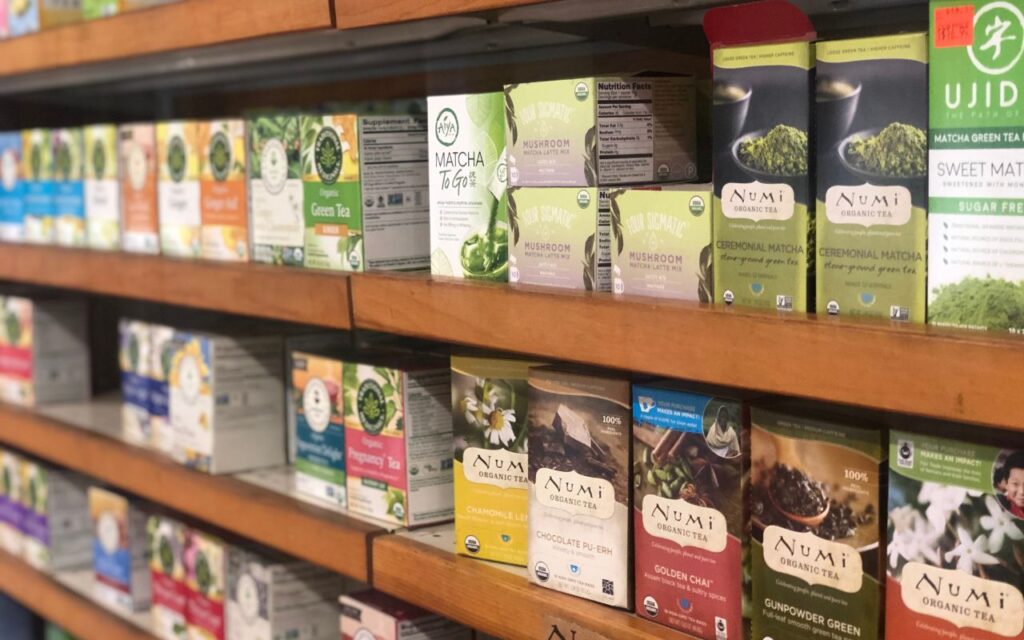Learn all about the health benefits of green tea related to EGCG green tea compounds, as well as how to make green tea the healthy way in this nutrition guide.
Sipping a cup of green tea, whether hot, cold, or in a bottled beverage, is an increasingly popular pastime for Americans. Today, you can find green tea in everything from shampoo and face creams to muffins and ice cream. Popular in many countries in Asia, this plant-based beverage has much to offer: a bold flavor profile, a light energy boost with zero calories, and an increasing body of research demonstrating potential health benefits.

History of Green Tea
Legend has it that green tea was first discovered in China, where it was used widely for its medicinal effects during the Han dynasty (25–220 AD). Later, during the Tang dynasty (600-900 AD), people began drinking green tea for pure pleasure.
What about black tea vs green tea? Like black and oolong tea, green tea is made from the Camellia sinensis plant leaves. What makes green tea unique is that the mature tea leaves are steamed, rolled, and dried directly after picking without allowing for oxidation, producing a tea that tastes closest to the fresh leaves. In contrast, black and oolong tea is oxidized, turning the leaves brown and giving it an intense flavor.
Science on Green Tea Benefits
Scientists have identified high levels of compounds in brewed teas called catechin flavonoids, which possess anti-inflammatory, antioxidant, and anticarcinogenic effects. Green tea, in particular, contains the catechin epigallocatechin gallate (EGCG), which may be at the root of green tea’s health benefits. EGCG green tea compounds work as a powerful antioxidant. Antioxidants decrease the free radicals, which are harmful at high levels, in our bodies by neutralizing them. Antioxidants keep free radicals at safe levels in the body.
There are numerous health benefits associated with green tea consumption. In addition to their antioxidant status, these beneficial compounds in green tea possess anticarcinogenic and anti-inflammatory properties, and are linked with benefits for healthy weight and improved cognitive function.

Potential Anticarcinogenic Benefits of Green Tea
Studies show that green tea may inhibit the development and formation of cancer in animals; it’s been linked with protection in many sites, such as skin, lung, mouth, stomach, colon, pancreas, bladder, and prostate. Currently, more research is being done on humans. In particular, green tea is correlated with inhibiting tumor growth. The EGCG and quercetin in green tea seem to be responsible for its anticarcinogenic properties. A study examining the effects of green tea on breast tumors in mice showed that when EGCG was administered orally in conjunction with quercetin, tumor volumes were reduced compared to the control. A study in 2017 examined how EGCG impacted breast cancer cells. The EGCG found in green tea promoted apoptosis (cell death) of cancerous cells at significantly higher rates than the control group. Scientists believe EGCG prompts a gene called P53. According to the study, P53 is responsible for tumor suppression. Additional studies in humans need to be conducted to verify these study results.
Healthy Weight Benefits of Green Tea
The effects of green tea have been shown to improve satiety (the feeling of fullness) when consumed before meals. A clinical study published in 2017 looked at metabolic and hormonal factors among overweight and obese women with PCOS, and investigated how those factors are affected by green tea consumption. The study looked at 60 subjects and randomly divided them into two groups: a group that received green tea and another group that received a placebo. Participants’ weights were taken before and after the twelve-week trial. At the end of the twelve weeks, women in the experimental group showed a statistically significant amount of weight loss compared to the control group. A randomized control trial studied 14 individuals who were grouped into either consuming 300 ml green tea or water. Individuals in the green tea group reported greater satiety. Although this study is small, it shows that green tea may be helpful in weight maintenance or loss. Additional research is needed to understand these potential benefits.

Anti-inflammatory Benefits of Green Tea
Consuming green tea regularly is related to a reduced risk of inflammation-related diseases, such as cardiovascular disease, type 2 diabetes, and metabolic syndrome. Green tea consumption increases adiponectin levels, a hormone released in fat tissues. When adiponectin levels are increased, the creation of foam cells (which play a pivotal role in atherosclerosis) is inhibited, as well as levels of interleukin 6 (high levels in the body are related to inflammation).
Improved Cognitive Function with Green Tea
Researchers have been looking into the risk of developing cognitive impairments related to inflammatory levels in the body. The properties of green tea have been shown to reduce levels of inflammation. When inflammatory markers are lower, neuroinflammation is reduced. These effects are believed to help prolong the onset of Alzheimer’s Disease and dementia; however, more research must be conducted before making conclusions.

Look to the Future of Green Tea
Although research is continually being done on green tea, there are still gaps in the literature. Green tea has been associated with many additional health benefits, like decreased risk of CVD, metabolic syndrome, and type 2 diabetes, but we need more research on the health benefits of green tea before we can understand its full health potential. In the meantime, there doesn’t seem to be a downside to sipping green tea unless you are sensitive to its caffeine content. How much caffeine in green tea? It contains 9 – 50 milligrams per cup, compared with coffee’s 72 – 130.

How to Make Green Tea
If you’re using green tea in bags or loose leaf green tea it’s super easy.
- Boil 1 cup of water at about 212℉ in a kettle.
- Add 1 green tea bag (or 1 teaspoon loose leaf green tea in a tea strainer) to a small tea pot or mug.
- Pour over the boiling water.
- Brew tea for about 2-3 minutes.
- Remove tea bag or tea strainer.
- Enjoy immediately.
- To make iced green tea, stir in 1 cup of ice cubes until melted.
- Add sliced lemon if desired.
Try these recipes featuring green tea.
Cranberry Iced Green Tea
Mint Green Tea Vinaigrette
Iced Green Tea with Lemon and Cucumbers
Learn more about the relaxing benefits of tea here.
For more blogs on health benefits of plant based foods, check out the following:
Quinoa Cooking Guide: Quinoa Health Benefits + Vegan Quinoa Recipes
How to Cook Mushrooms + Health Benefits of Mushrooms
Tempeh vs Tofu
Guide to Mango Health Benefits
As an Amazon Influencer, I earn from qualifying purchases. For more information about affiliate links, click here.
More Tools for Eating and Living the Goodness
Written by Sharon Palmer, MSFS, RDN with Brittany Mackey, dietetic intern
References:
- Effects of green tea, matcha tea and their components epigallocatechin gallate and quercetin on MCF‑7 and MDA-MB-231 breast carcinoma cells. https://www.spandidos-publications.com/10.3892/or.2018.6789?text=fulltext
- Health Benefits and Chemical Composition of Matcha Green Tea: A Review https://www.mdpi.com/1420-3049/26/1/85#B74-molecules-26-00085
- Mechanism of EGCG promoting apoptosis of MCF-7 cell line in human breast cancer. https://www.ncbi.nlm.nih.gov/pmc/articles/PMC5588052/
- Green Tea Catechins and Cardiovascular Health: An Update https://www.ncbi.nlm.nih.gov/pmc/articles/PMC2748751/#:~:text=Several%20studies%20reveal %20that%20green,health%20benefits%20of%20green%20tea.
- Effect of green tea on metabolic and hormonal aspect of polycystic ovarian syndrome in overweight and obese women suffering from polycystic ovarian syndrome: A clinical trial https://www.ncbi.nlm.nih.gov/pmc/articles/PMC5441188/
- Coffee or tea: Anti-inflammatory properties in the context of atherosclerotic cardiovascular disease prevention https://www.sciencedirect.com/science/article/pii/S1043661822005424

